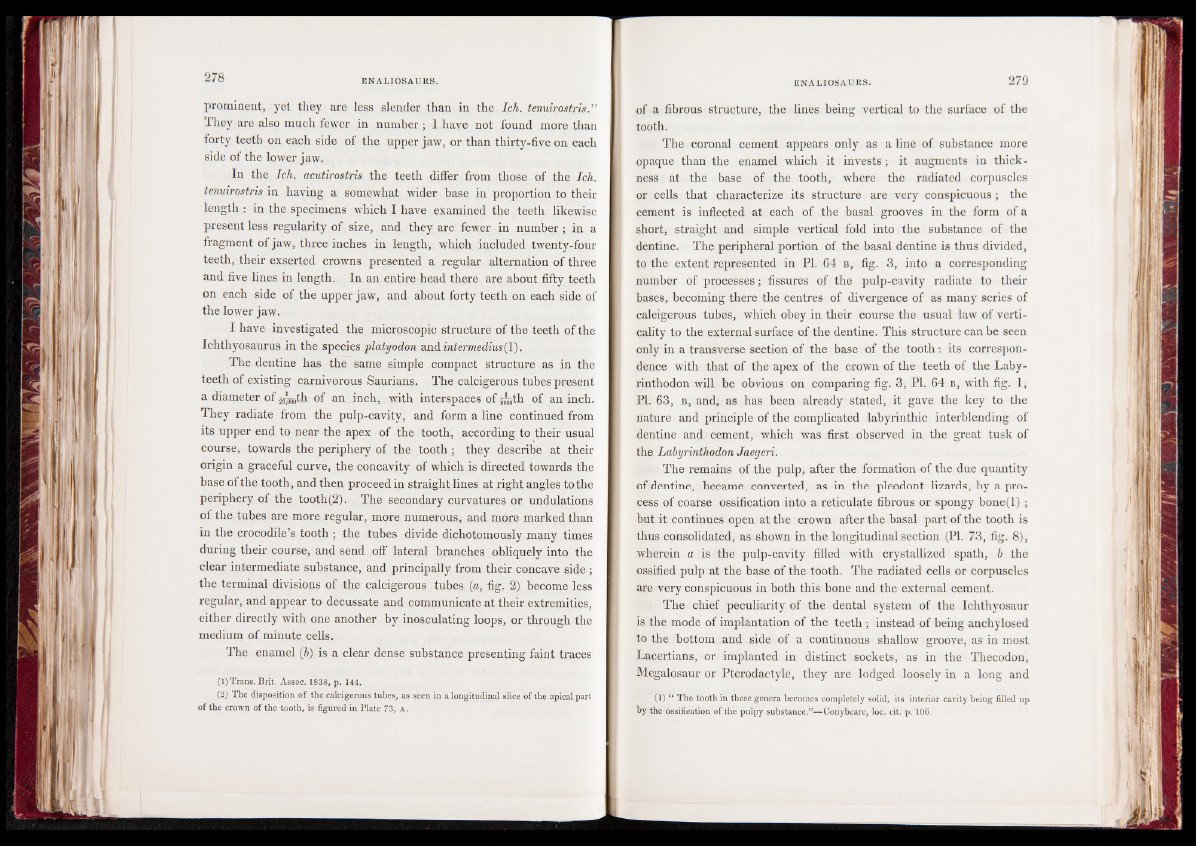
prominent, yet they are less slender than in the Ich. tenuirostris.”
They are also much fewer in number ; 1 have not found more than
forty teeth on each side of the upper jaw, or than thirty-five on each
side of the lower jaw.
In the Ich. acutirostris the teeth differ from those of the Ich.
tenuirostris in having a somewhat wider base in proportion to their
length : in the specimens which I have examined the teeth likewise
present less regularity of size, and they are fewer in number; in a
fragment of jaw, three inches in length, which included twenty-four
teeth, their exserted crowns presented a regular alternation of three
and five lines in length. In an entire head there are about fifty teeth
on each side of the upper jaw, and about forty teeth on each side of
the lower jaw.
I have investigated the microscopic structure of the teeth of the
Ichthyosaurus in the species platyodon and intermedius(1).
The dentine has the same simple compact structure as in the
teeth of existing carnivorous Saurians. The calcigerous tubes present
a diameter of jp^th of an inch, with interspaces of 5555th of an inch.
They radiate from the pulp-cavity, and form a line continued from
its upper end to near the apex of the tooth, according to their usual
course, towards the periphery of the tooth; they describe at their
origin a graceful curve, the concavity of which is directed towards the
base of the tooth, and then proceed in straight lines at right angles to the
periphery of the tooth (2). The secondary curvatures or undulations
of the tubes are more regular, more numerous, and more marked than
in the crocodile’s tooth ; the tubes divide dichotomously many times
during their course, and send off lateral branches obliquely into the
clear intermediate substance, and principally from their concave side ;
the terminal divisions of the calcigerous tubes (a, fig. 2) become less
regular, and appear to decussate and communicate at their extremities,
either directly with one another by inosculating loops, or through the
medium of minute cells.
The enamel (6) is a clear dense substance presenting faint traces
(1) Trans. Brit. Assoc. 1838, p. 144.
(2) The disposition of the calcigerous tubes, as seen in a longitudinal slice of the apical part
of the crown of the tooth, is figured in Plate 73, A.
of a fibrous structure, the lines being vertical to the surface of the
tooth.
The coronal cement appears only as a line of substance more
opaque than the enamel which it invests ; it augments in thickness
at the base of the tooth, where the radiated corpuscles
or cells that characterize its structure are very conspicuous ; the
cement is inflected at each of the basal grooves in the form of a
short, straight and simple vertical fold into the substance of the
dentine. The peripheral portion of the basal dentine is thus divided,
to the extent represented in PI. 64 b , fig. 3, into a corresponding
number of processes; fissures of the pulp-cavity radiate to their
bases, becoming there the centres of divergence of as many series of
calcigerous tubes, which obey in their course the usual law of verti-
cality to the external surface of the dentine. This structure can be seen
only in a transverse section of the base of the tooth : its correspondence
with that of the apex of the crown of the teeth of the Laby-
rinthodon will be obvious on comparing fig. 3, PL 64 b , with fig. 1,
PL 63, b , and, as has been already stated, it gave the key to the
nature and principle of the complicated labyrinthic interblending of
dentine and cement, which was first observed in the great tusk of
the Labyrinthodon Jaegeri.
The remains of the pulp, after the formation of the due quantity
of dentine, became converted, as in the pleodont lizards, by a process
of coarse ossification into a reticulate fibrous or spongy bone(l) ;
hut it continues open at the crown after the basal part of the tooth is
thus consolidated, as shown in the longitudinal section (PL 73, fig. 8),
wherein a is the pulp-cavity filled with crystallized spath, b the
ossified pulp at the base of the tooth. The radiated cells or corpuscles
are very conspicuous in both this hone and the external cement.
The chief peculiarity of the dental system of the Ichthyosaur
is the mode of implantation of the teeth ; instead of being anchylosed
to the bottom and side of a continuous shallow groove, as in most
Lacertians, or implanted in distinct sockets, as in the Thecodon,
Megalosaur or Ptérodactyle, they are lodged loosely in a long and
(1) “ The tooth in these genera becomes completely solid, its interior cavity being filled up
by the ossification of the pulpy substance/’—Conybeare, loc. cit. p. 106.